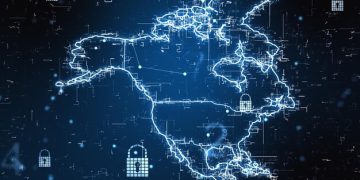Cybersecurity Job Growth US: Demand Skills for 2026 Revealed

The landscape of cybersecurity jobs in the U.S. is rapidly evolving, with significant growth projected by 2026, driven by an increasing demand for specialized skills in cloud security, AI-centric defense, data privacy, and threat intelligence to combat sophisticated cyber threats effectively.
The digital age, a realm where daily life, global commerce, and national security converge, faces an escalating threat landscape. As cyberattacks grow in sophistication and frequency, the demand for skilled cybersecurity professionals in the U.S. has never been more critical. Exploring Cybersecurity Job Growth in the US: What Skills Will Be Most in Demand by 2026? offers a vital glimpse into the future of a rapidly expanding field.
The Expanding Horizon of Cybersecurity Careers
The digital transformation across all sectors has unfortunately broadened the attack surface for malicious actors. This expansion necessitates a robust defense, fueling an unprecedented demand for cybersecurity expertise. From protecting critical infrastructure to securing personal data, the roles within cybersecurity are diversifying rapidly, creating a dynamic job market.
The U.S. Bureau of Labor Statistics (BLS) projects a significant increase in employment for information security analysts, far outpacing the average for all occupations. This growth is not merely quantitative; it speaks to a qualitative shift in the skills required to address emerging threats. Understanding these shifts is paramount for aspiring professionals and educational institutions alike.
Drivers of Demand in Cybersecurity
Several key factors are contributing to this surge in demand. The pervasive adoption of cloud computing, the proliferation of IoT devices, and the increasing reliance on big data analytics all introduce new vulnerabilities that require specialized security measures. Furthermore, regulatory compliance frameworks worldwide are becoming stricter, mandating higher levels of data protection and privacy, which in turn elevates the need for expert compliance officers and privacy engineers.
- Digitalization Acceleration: More businesses are moving operations online, increasing exposure.
- Sophistication of Threats: Cybercriminals are employing advanced persistent threats (APTs) and AI-driven attacks.
- Regulatory Pressures: Laws like GDPR and CCPA necessitate stringent data security practices.
- Shortage of Skilled Professionals: A long-standing skills gap means more roles are opening than can be filled.
The sheer volume and complexity of cyber threats, from nation-state sponsored attacks to ransomware gangs, underline the urgency. Each successful breach serves as a stark reminder of the vital role cybersecurity plays in maintaining trust and continuity in our interconnected world. This constant evolution ensures that the cybersecurity field remains one of the most intellectually stimulating and impactful career paths.
As we delve deeper into the specific areas of skill demand, it becomes clear that a foundational understanding combined with specialized knowledge will be the hallmark of successful cybersecurity professionals by 2026. The field is not static; continuous learning and adaptation are not just encouraged, but essential.
Emerging Skillsets: Beyond Traditional Security
While foundational cybersecurity knowledge remains crucial, the industry is rapidly evolving, demanding new and specialized skillsets. The future of cybersecurity professional development leans heavily into areas that address the complexities of modern IT infrastructure and the ingenuity of cyber adversaries. No longer is it enough to simply understand firewalls and antivirus; a deeper, more systemic approach is required.
Cloud Security Expertise
With businesses migrating critical operations to cloud platforms like AWS, Azure, and Google Cloud, securing these distributed environments has become a top priority. Cloud security professionals mitigate risks associated with data breaches, misconfigurations, and unauthorized access in a multi-tenant environment. This involves understanding an array of cloud-native security tools and shared responsibility models.
Professionals in this domain need to master platform-specific security best practices, identity and access management (IAM) within cloud ecosystems, and microservices security. The ability to architect and implement secure cloud solutions will be invaluable. They also need to be adept at continuous monitoring and compliance within dynamic cloud infrastructures, which often differ significantly from on-premise setups.
Artificial Intelligence and Machine Learning in Security
AI and machine learning (ML) are dual-edged swords in cybersecurity: they are used by attackers to enhance sophisticated threats, and by defenders to automate threat detection, analysis, and response. Skills in AI/ML for security involve understanding how to deploy and manage AI-driven security tools, interpret their outputs, and even develop new algorithms for anomaly detection and predictive analysis.
This includes proficiency in areas like natural language processing for threat intelligence, behavioral analytics for detecting insider threats, and deep learning for identifying novel malware variants. Professionals contributing to this space bridge the gap between data science and cybersecurity, bringing innovative solutions to complex problems that human analysts might miss due to volume or speed.
Moving forward, the ability to leverage AI effectively, from understanding its strengths and limitations to deploying it responsibly, will differentiate top-tier cybersecurity experts. It’s not just about using the tools, but contributing to their evolution and strategic implementation.
The Crucial Role of Data Privacy and Compliance
In an era defined by data, the protection of personal and sensitive information has transcended a mere technical requirement to become a fundamental ethical and legal imperative. The landscape of data privacy and compliance is complex, continuously evolving, and critically important for any organization operating in the digital sphere. Professionals skilled in this area act as guardians of data, ensuring legal obligations are met while fostering trust with customers and stakeholders.
Navigating Regulatory Frameworks
The global proliferation of data privacy regulations underscores the heightened importance of this domain. Beyond North America, major frameworks such as the General Data Protection Regulation (GDPR) in Europe continue to influence international data handling practices. Domestically, the California Consumer Privacy Act (CCPA) and its successor, the California Privacy Rights Act (CPRA), set high standards for consumer data protection in the U.S. Other states are following suit, creating a patchwork of requirements that necessitates careful navigation.
Professionals must possess an in-depth understanding of these regulations, including their scope, requirements for data collection, processing, storage, and deletion, as well as the rights they grant to individuals. This often involves developing and implementing robust data governance policies, conducting privacy impact assessments (PIAs), and ensuring mechanisms are in place for data subject requests. The ability to translate complex legal jargon into actionable technical and procedural steps is a highly valued skill.
Privacy Engineering and by Design Principles

The concept of “Privacy by Design” (PbD) has become a cornerstone of modern data protection strategies. It advocates for embedding privacy considerations into the design and architecture of IT systems, business practices, and organizational operations from the outset, rather than as an afterthought. Privacy engineers are at the forefront of this movement, working closely with product development teams, software engineers, and system architects to ensure privacy is built into solutions from the ground up.
Key skills in privacy engineering include cryptographic expertise, secure coding practices, anonymization and pseudonymization techniques, and the ability to design privacy-preserving data analytics solutions. They are crucial in mitigating privacy risks preemptively, reducing the likelihood of costly data breaches and regulatory fines. This proactive approach not only enhances security but also fosters consumer confidence.
- Regulatory Acumen: Deep knowledge of GDPR, CCPA, HIPAA, and other global and local privacy laws.
- Risk Assessment: Ability to identify, evaluate, and mitigate privacy risks proactively.
- Policy Development: Crafting and implementing comprehensive data governance and privacy policies.
- Audit and Assurance: Conducting regular audits to ensure ongoing compliance and prepare for regulatory scrutiny.
The role of data privacy and compliance professionals is not just about avoiding penalties; it’s about building a culture of trust and responsibility around data. As data becomes an increasingly valuable asset, ensuring its ethical and secure handling will remain a paramount concern for organizations, thereby cementing the demand for experts in this specialized field.
Threat Intelligence and Incident Response Mastery
In the relentless battle against cyber adversaries, mere defensive postures are no longer sufficient. Organizations must adopt proactive strategies, staying ahead of potential threats and responding effectively when breaches occur. This critical dual mandate falls squarely on the shoulders of professionals skilled in threat intelligence and incident response, two interconnected disciplines that form the backbone of modern cyber resilience.
Proactive Threat Intelligence
Threat intelligence involves collecting, processing, and analyzing information about potential or actual threats to an organization. This includes understanding the motives, tactics, techniques, and procedures (TTPs) of cybercriminals, nation-state actors, and other malicious entities. The goal is to provide actionable insights that enable organizations to anticipate attacks, strengthen their defenses, and allocate resources effectively.
Skills in this area encompass open-source intelligence (OSINT) gathering, dark web monitoring, malware analysis, and vulnerability research. Professionals must be adept at using various threat intelligence platforms and frameworks, interpreting complex data, and effectively communicating findings to both technical and non-technical stakeholders. This involves not just identifying threats, but understanding their potential impact and recommended countermeasures.
Rapid Incident Response Capabilities
Despite best efforts in prevention, incidents are inevitable. When a cyberattack occurs, a swift and systematic incident response is crucial to minimize damage, restore operations, and prevent recurrence. Incident response professionals are the first line of defense after a breach, executing a planned sequence of actions to contain, eradicate, and recover from security incidents.
Key skills include digital forensics, root cause analysis, malware reverse engineering, and sophisticated log analysis. They must be calm under pressure, possess strong problem-solving abilities, and be able to coordinate with various internal and external teams, including legal, PR, and law enforcement. The ability to articulate the scope of an incident, its impact, and the steps taken to mitigate it is paramount.
- Forensic Analysis: Uncovering the details of a breach through digital evidence.
- Containment and Eradication: Stopping the attack and removing the threat from systems.
- Recovery and Post-Mortem: Restoring affected systems and learning from the incident.
- Communication: Clearly conveying incident status and impact to stakeholders.
The synergy between threat intelligence and incident response is powerful. Intelligence gathered from past incidents informs future prevention strategies, while continuous threat monitoring helps identify new attack vectors that could lead to incidents. Organizations that excel in both these areas are far better positioned to weather the storms of the cyber world, making these skills highly sought after in the evolving cybersecurity landscape.
Securing Operational Technology (OT) and IoT
As the digital and physical worlds increasingly merge, the security of operational technology (OT) and the vast network of Internet of Things (IoT) devices has emerged as a critical frontier in cybersecurity. Historically separated from traditional IT networks, OT systems—which control industrial processes, critical infrastructure, and specialized equipment—are now becoming interconnected, introducing new and complex vulnerabilities. Securing these environments requires a distinctive set of skills and a deep understanding of unique operational contexts.
Challenges in OT Security
Unlike conventional IT systems, OT environments often involve legacy hardware and software that were not designed with modern cybersecurity threats in mind. Patching and updating these systems can be challenging due to their continuous operational requirements and the potential for disrupting critical services. Furthermore, the convergence of IT and OT networks means that a breach in one system can quickly propagate to the other, leading to significant physical impacts, service disruptions, or even safety hazards.
Professionals in OT security need to understand industrial control systems (ICS), SCADA (Supervisory Control and Data Acquisition) systems, and distributed control systems (DCS). They must be familiar with specific industrial communication protocols and the unique vulnerabilities associated with them. The focus shifts from protecting data confidentiality to ensuring system availability and integrity, as a minor disruption can have major real-world consequences.
Skills required include network segmentation for OT environments, risk assessments tailored to industrial systems, and implementing monitoring solutions that detect anomalous behaviors specific to operational contexts. The ability to work within strict uptime requirements and understanding safety implications of security measures are paramount.
Safeguarding the Internet of Things (IoT)

The proliferation of IoT devices, from consumer smart appliances to industrial sensors and medical devices, has created an enormous attack surface. Many IoT devices are designed with minimal security features, making them easy targets for botnets, data exfiltration, and unauthorized access. Securing these diverse and often resource-constrained devices poses unique challenges.
IoT cybersecurity specialists must be knowledgeable about embedded systems security, firmware analysis, and secure device authentications. They need to understand the entire lifecycle of an IoT device, from manufacturing and deployment to end-of-life, ensuring security considerations are integrated at every stage. This often involves working closely with hardware engineers and product designers to embed security from the ground up.
- Vulnerability Management: Identifying and addressing weaknesses in OT and IoT devices.
- Network Segmentation: Isolating critical systems to limit the spread of attacks.
- Risk Assessment: Evaluating unique threats and impacts in industrial and device environments.
- Compliance: Adhering to standards specific to OT/IoT security (e.g., NIST, IEC).
The demand for this specialized expertise will only grow as more industries adopt IoT and integrate OT with their IT infrastructure. Professionals who can bridge the gap between cyber and physical security, ensuring the resilience and safety of both, will be indispensable by 2026.
Building a Resilient Cybersecurity Workforce
The projected growth in cybersecurity jobs by 2026 is undeniable, but it comes with a significant challenge: bridging the existing skills gap. Building a resilient cybersecurity workforce requires a multifaceted approach, encompassing education, training, certification, and a commitment to lifelong learning. It’s not just about filling positions; it’s about cultivating a deep bench of adaptive and highly capable professionals ready for tomorrow’s threats.
Education and Training Pipelines
Universities, colleges, and vocational schools play a crucial role in preparing the next generation of cybersecurity experts. Comprehensive curricula that blend theoretical knowledge with practical, hands-on experience are essential. This includes topics ranging from network fundamentals and operating systems to advanced cryptography, ethical hacking, and secure software development. Partnerships between academia and industry can ensure that educational programs remain relevant to real-world demands.
Beyond traditional degrees, bootcamps and specialized training programs are emerging as effective pathways to quickly upskill individuals or transition professionals from other fields into cybersecurity. These programs often focus on highly sought-after skills, providing intensive, practical training that leads directly to employment opportunities.
The Importance of Certifications
Certifications serve as valuable benchmarks of proficiency and specialization in cybersecurity. Recognized industry certifications demonstrate a professional’s commitment to continuous learning and their mastery of specific domains. While not a substitute for experience, they can significantly enhance career prospects and validate a candidate’s expertise for employers. Some of the most highly regarded certifications include:
- CompTIA Security+: Entry-level, foundational knowledge.
- (ISC)² CISSP (Certified Information Systems Security Professional): Advanced, management-level security.
- CISM (Certified Information Security Manager): Focus on information security governance and program development.
- OSCP (Offensive Security Certified Professional): Hands-on penetration testing.
- Cloud-specific certifications (e.g., AWS Certified Security, Azure Security Engineer Associate): Validates cloud security expertise.
These certifications not only validate technical skills but often require ethical conduct and ongoing professional development, reinforcing the professionalism of the field.
Fostering Continuous Learning and Adaptability
The cybersecurity landscape is in constant flux. New threats, technologies, and vulnerabilities emerge daily, meaning that what is relevant today may be obsolete tomorrow. Therefore, a commitment to continuous learning and adaptability is arguably the most critical attribute for any cybersecurity professional. This involves staying updated with industry trends, participating in threat intelligence communities, attending conferences, and engaging in self-study.
Organizations must also invest in their workforce, providing opportunities for professional development, cross-training, and access to the latest tools and resources. Creating a culture that encourages knowledge sharing and enables experimentation can significantly enhance the collective expertise and resilience of a cybersecurity team. The future belongs to those who actively embrace change and view learning as an ongoing journey, not a destination.
Bridging the Cybersecurity Talent Gap: Strategies for Success
The persistent gap between the demand for cybersecurity professionals and the available skilled workforce presents a significant challenge to organizations and national security. Addressing this requires a multi-pronged approach that goes beyond traditional recruitment and focuses on nurturing talent, fostering diversity, and adapting to the evolving nature of work. Filling this gap is crucial not just for individual companies, but for the resilience of the economy and critical infrastructure as a whole.
Investing in Upskilling and Reskilling
Many organizations are realizing that they don’t always need to look external for talent. Investing in current employees through upskilling and reskilling initiatives can be a highly effective strategy. This involves identifying employees in other departments—such as IT support, network administration, or even non-technical roles—who demonstrate an aptitude for problem-solving, critical thinking, and a keen interest in security. Providing them with dedicated training, mentorship, and opportunities to transition into cybersecurity roles can create a loyal and effective workforce.
These internal candidates often bring valuable institutional knowledge and a deeper understanding of the organization’s unique operational nuances, which can be immensely beneficial in a security context. Programs might include tuition reimbursement for certifications, internal bootcamps, and rotational assignments within security teams.
Promoting Diversity and Inclusion
The cybersecurity field has historically lacked diversity. Expanding the talent pool by actively recruiting individuals from diverse backgrounds—including women, minorities, and veterans—is not only an ethical imperative but also a strategic advantage. Diverse teams bring varied perspectives, problem-solving approaches, and experiences, leading to more robust and innovative security solutions. A wider range of viewpoints can help identify blind spots in threat analysis and strategy development.
Initiatives to promote diversity include partnering with minority-serving institutions, offering scholarships and internships for underrepresented groups, and fostering inclusive workplace cultures where all voices are heard and valued. Addressing unconscious bias in hiring processes is also critical to ensure a level playing field for all candidates.
Embracing Non-Traditional Pathways and Remote Work
Not all skilled cybersecurity professionals fit the mold of a traditional four-year degree holder. Recognizing and validating skills gained through self-study, open-source contributions, military service, or non-traditional educational programs can significantly broaden the talent pool. Emphasizing practical competency over formal qualifications can unlock hidden talent.
Furthermore, the increased acceptance of remote work has opened up opportunities to recruit talent from a wider geographical area, reducing immediate competition in specific metros. Offering flexible work arrangements can also attract professionals who may not have been able to participate in the traditional workforce structure, such as caregivers or those in rural areas. This flexibility can be a significant differentiator in attracting and retaining top-tier talent in a competitive market.
- Mentorship Programs: Connecting experienced professionals with aspiring ones.
- Apprenticeships: Structured on-the-job training combined with academic learning.
- Cybersecurity Competitions: Identifying and nurturing talent through challenges and hackathons.
- Cross-Sector Collaboration: Sharing knowledge and resources between government, academia, and industry.
Ultimately, bridging the cybersecurity talent gap is a shared responsibility that requires sustained effort from educators, employers, and policymakers. By investing in talent development, fostering inclusive environments, and embracing innovative recruitment strategies, the U.S. can build a formidable and resilient cybersecurity workforce by 2026 and beyond.
| Key Area | Brief Description |
|---|---|
| ☁️ Cloud Security | Expertise in securing dynamic cloud environments (AWS, Azure, GCP). |
| 🛡️ AI & ML Security | Leveraging AI/ML for advanced threat detection and defense automation. |
| ⚙️ OT & IoT Security | Protecting industrial control systems and widespread IoT devices. |
| 📊 Data Privacy | Ensuring compliance with evolving data protection regulations and design. |
Frequently Asked Questions About Cybersecurity Careers
The U.S. Bureau of Labor Statistics (BLS) projects a significant growth for information security analysts, estimating a much faster than average increase compared to other occupations. This indicates robust demand for cybersecurity professionals across various industries, driven by the escalating complexity and frequency of cyber threats globally.
By 2026, highly sought-after skills will include cloud security expertise, strong capabilities in AI/ML for threat analysis, proficiency in data privacy and compliance (e.g., GDPR, CCPA), and advanced threat intelligence and incident response. Operational Technology (OT) and IoT security will also see significant demand as these sectors become more interconnected.
Yes, cybersecurity certifications are highly valuable. They demonstrate specialized knowledge and a commitment to ongoing professional development. Certifications like CompTIA Security+, (ISC)² CISSP, CISM, and cloud-specific credentials (AWS, Azure) can significantly enhance job prospects and validate a professional’s expertise to potential employers in a competitive market.
Entry into cybersecurity can be achieved through various paths, including bachelor’s or master’s degrees in computer science or cybersecurity, specialized bootcamps, and industry certifications. Gaining practical experience through internships, capture-the-flag events, or open-source contributions is also crucial. Networking within the industry is highly recommended.
AI and ML will be pivotal in automating threat detection, accelerating incident response, and performing predictive analysis. Professionals with skills in deploying and managing AI-driven security tools, interpreting their outputs, and even developing new algorithms for anomaly detection will be critical in combating increasingly sophisticated, AI-enhanced cyber threats.
Conclusion
The journey toward 2026 promises a cybersecurity landscape that is both challenging and replete with opportunities. The anticipated growth in cybersecurity jobs in the U.S. reflects a clear and urgent demand for a workforce equipped to navigate the complexities of evolving digital threats. By prioritizing specialization in areas like cloud security, AI-centric defense, data privacy, and the unique challenges of OT and IoT, professionals can position themselves at the forefront of this vital field. Continuous learning, adaptability, and a commitment to rigorous ethical practices will not only define individual success but also collectively strengthen our digital defenses against pervasive cyber risks.





